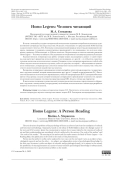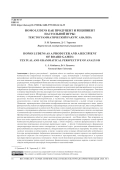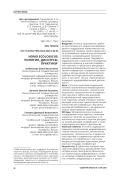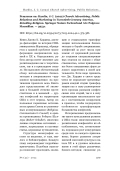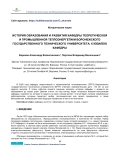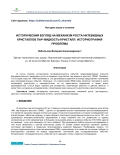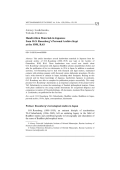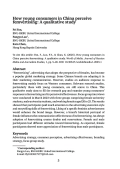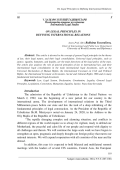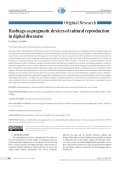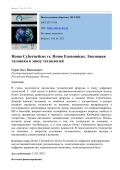В статье с позиций культурно-исторической методологии поднимается проблема психологии художественной литературы как вида искусства. Отдельно, отталкиваясь от представлений М. М. Бахтина о диалогичности текста и А. Н. Леонтьева о коммуникативной природе искусства, рассматриваются вопросы, связанные с созданием художественных произведений и их пониманием, что получило отражение в разделах «Работа автора» и «Работа читателя». Встреча автора и читателя означает рождение Homo Legens — Человека читающего. Исследованию этого феномена и посвящена данная публикация.
Художественную литературу (как работу автора) можно анализировать двояко: с одной стороны, она выступает предметом психологического исследования, а с другой — ее субъектом, самостоятельным носителем психологического знания. В первом случае литература представляет собой либо объект научно-психологического изучения, либо его средство; во втором — обосновывается возможность отношения к литературе как к носителю вненаучного психологического знания, чем и обусловлено ее психотехническое воздействие на читателя.
Восприятие литературного произведения читателем (работа читателя) анализируется с художественных и научных позиций, которые взаимодополняют друг друга. С опорой на представления Л. С. Выготского об активности эстетического переживания и учение об интериоризации П. Я. Гальперина обосновывается точка зрения, согласно которой понимание литературного произведения читателем есть процесс его активного воссоздания, что созвучно представлениям В. Ф. Асмуса о чтении как творчестве.
В заключение на примере художественной литературы делается вывод о продуктивности обращения к научным и вненаучным (литературным) источникам психологического знания при разработке вопросов психологии искусства.
В фокусе рассуждений - продукт одного из наиболее популярных видов рекреационной деятельности современных носителей культуры - игра, возникающая с помощью использования разнообразных средств разных культурных кодов, которыми на определенный момент располагает та или иная языковая культура. Игра как таковая интерпретируется в качестве процесса и результата рекреационной, кооперативной деятельности носителей языка и культуры, выступающих в одной из своих ипостасей - Homo ludens. С текстотипологических позиций игра описывается как текст из класса директивных/прескриптивных, при порождении которого используются средства вербального и нескольких невербальных культурных кодов, как одна из разновидностей текстов из класса «инструкции». Это дает основание трактовать тексты анализируемого типа как креолизованный (полимодальный, семиотически гетерогенный) текст. Инструкция к настольной игре описывается вместе с тем как гибридный текст, поскольку в содержательной и формальной микро- и макроорганизации таких текстов используются различные техники текстопорождения, в частности, текстов нарративных, экспликативных и аксиологических, а также текстов художественных, публицистических, а в ряде случаев и научных. Названные характеристики объясняют полифункциональность текста анализируемого типа, причем функции текста, такие как информативная, социализирующая, аксиологическая и др., явно и опосредованно подчинены рекреационной и людической. Последние в свою очередь реализуются преимущественно и, как правило, в кооперативном общении носителей языка и культуры. Содержательно в тексте «инструкция к настольной игре» нелинейно сочленяются сведения из реального, фикционального и виртуального миров. Продуцент(ы) и реципиенты настольной игры в процессе порождения и восприятия соответствующего текста выступают в одной из своих многочисленных ипостасей - как Homo ludens. Это позволяет им более или менее определенно и более или менее беспроблемно разграничивать в процессе самой игровой деятельности фикциональный и реальный миры, с одной стороны, а также фикциональный и один из множества потенциально возможных виртуальных миров - с другой. Содержательная и формальная макроструктура текста типа «инструкция к настольной игре», располагающая обязательными и факультативными макрокомпонентами, обнаруживает последовательную маркировку последних через систему заголовков и подзаголовков, а также символов и/или условных обозначений либо необходимого для игры инструментария, добровольно принимаемых участниками игрового процесса на определенный временной отрезок для конкретного текстового пространства, конструируемого в игровом пространственно-временном континууме. Такой способ текстовой организации облегчает участникам игры распознавание границ между реальным, фикциональным и виртуальным мирами, а также способствует поддержанию атмосферы кооперативного взаимодействия.
Введение. В статье поднимается проблема категориального выражения формирования и поддержания экологического мировоззрения человека, ориентированного на установление гармоничных отношений человека с развивающимся технологическим и цифровым миром. Проработка содержательного наполнения исследуемых терминов отражена в анализе современного научного и публичного дискурсов и материалов Всероссийской научно-практической конференции «Современные материалы и методы решения экологических проблем постиндустриальной агломерации », в частности, секции «Гуманитарные основания природосберегающей деятельности ».
Цель. Уточнить смысловое содержание понятий «экологическое мировоззрение», «экологическое сознание», «экологичное мышление», «экологичность» в современном научном и публичном дискурсах. В публикационной представленности этих терминов на базе ключевых тезисов докладов участников гуманитарной секции экологической конференции. Изучается научная востребованность, междисциплинарное заимствование терминов.
Методы. Методологические основания исследования статьи связаны с анализом указанных понятий, их смысловых и семантических акцентов в научном дискурсе, на основе докладов конференций, а также экориторики в интернет-пространстве. Научная новизна. Уточнено содержание терминов «экологическое мировоззрение», «экологическое сознание», «экологичное мышление», «экологичность» в теоретическом научном и современном публичном дискурсах в их корреляции с научными междисциплинарными практиками дискуссионных площадок конференции.
Результаты. В публичном интернет-пространстве оформилось дискурсивное поле, которое можно тематически обозначить как «экологизация цифровизации», согласно которому новейшие диджитал технологии способны предупреждать и решать некоторые экологические проблемы. Кроме того, можно утверждать, что термины «экологическое сознание» и «экология сознания» означают не только бережное отношение к природным ресурсам, но и ответственность за свои действия и позитивное отношение к миру в форме проактивного мышления (вместо реактивного), основанного на мировоззренческих установках экогуманизма и холизма.
Выводы. С середины прошлого столетия в отечественной и зарубежной философской и научной литературе отмечается необходимость активного формирования экологического мировоззрения, выраженного в сохранении и воспроизводстве ценностей заботы человека о природе, обществе, культуре и самом себе. Сегодня в условиях обострения экологических рисков, их научных и публичных обсуждений, поисков способов нивелирования таковых актуализируется вопрос изменения парадигмы мышления и деятельности современного человека в пользу заботливого, бережного и ответственного отношения к себе и окружающему миру. В этой связи в рассмотренных дискурсах наблюдается востребованность ментальных установок и повседневных практик, в которых проэкологическая активность проявлялась бы в качестве атрибутивного свойства человека экологичного (homo ecologicus). Смысловое поле интернет-пространства по экотематике коррелирует с научными междисциплинарными дискурсами дискуссионных площадок конференций, также отражая тем самым семантическую востребованность новых категорий в разнообразных дискурсах и научных практиках.
Рецензия на: Hardin, J. C. (2022) Church Advertising, Public Relations and Marketing in Twentieth-Century America. Retailing Religion. Springer Nature Switzerland AG: Palgrave Macmillan. — 395 p.
In 2025, the Department of Theoretical and Industrial Thermal Power Engineering (TPTE) of Voronezh State Technical University (VSTU) celebrates a significant date - 50 years since the first graduation. For this event it was decided to write a history of the department from the moment of its formation to the present day. This article, in our opinion, will be interesting to former graduates of the department, will raise their interest and pride for their “alma mater”. The article will be useful for modern employers, who will have to choose heat power engineering for their enterprise, as well as for applicants, who choose their future profession and the place of its obtaining.
The paper describes the historical sequence of events that predetermined the discovery of the fundamental vapor-liquid-solid (VLS) mechanism of nanowires growth. It is shown that the history of the discovery of the VLS mechanism and its further development does not always represent a logical series of consecutive events. It is noted that the classical VLS scheme is the key in the whiskers and nanowires growth, but it is not the only possible one, but has many varieties. The paper will be useful for graduate students beginning work in this field and may be of interest to researchers who have devoted their lives to crystal growth and crystallization.
This article introduces several handwritten materials in Japanese from the personal archive of O. O. Rosenberg (1888–1919) now kept at the Archive of Orientalists, IOM, RAS. These handwritten texts reveal new details about O. O. Rosenberg’s interaction with Japanese Buddhist scholars and publishers before and after the publication of his two dictionaries in 1916 in Japan. In addition to academic activities, O. O. Rosenberg had to deal with financial and legal matters, maintained contacts with printing company staff, discussed various diplomatic procedures. He also had a wide network of contacts in Japan, including other foreigners. Relying on this network and his fluent knowledge of Japanese, handwritten Japanese in particular, O. O. Rosenberg was able to complete his publication projects successfully. This study presents O. O. Rosenberg’s dictionaries as an important component of the project led by Th. I. Stcherbatsky to restore the terminology of Sanskrit philosophical treatises. Future work plans outlined by the young scholar demonstrate his exceptional diligence and competence in matters of Oriental philology. All documents, translated from Japanese by A. Lushchenko, are published for the first time.
“Femvertising”, advertising that adopts the perspective of females, has become a popular global marketing strategy. Some Chinese brands are adopting it in their marketing communication. However, studies on audience response to femvertising mainly focus on Western consumers. Relevant research studies, particularly those with young consumers, are still scarce in China. This qualitative study aims to fill the research gap and examine young consumers’ responses to femvertising and its perceived effectiveness. Focus group interviews were conducted in March 2023 with three groups comprising female university students, male university students, and working females aged 20 to 25. The results showed that participants paid much attention to the advertising execution style and storytelling skills of femvertising. Liking of a specific feminist advertisement would enhance the brand image. However, a brand’s historical portrayal of female influences the communication effectiveness of its femvertising. An abrupt adoption of femvertising creates doubts and reservations. Female and male participants had different attitudes toward femvertising. As expected, female participants showed more appreciation of femvertising than male participants.
Ushbu maqola huquq nazariyasidagi umumiy huquqiy tamoyillar tushunchasi, ularning huquqiy tabiati va huquqiy konsolidatsiyasiga bag’ishlangan. Adolat, tenglik, insonparvarlik va qonuniylik kabi Universal huquqiy tamoyillar davlat huquqiy siyosatining asosiy yo’nalishlari hisoblanadi. Maqolada, shuningdek, xalqaro huquqda huquqning umumiy tamoyillarining roli va ularning inson huquqlari Umumjahon Deklaratsiyasi, fuqarolik va siyosiy huquqlar to’g’risidagi xalqaro Pakt, 1966 yilgi iqtisodiy, ijtimoiy va madaniy huquqlar to’g’risidagi xalqaro Pakt kabi asosiy xalqaro huquqiy hujjatlarda xalqaro huquqiy konsolidatsiyasi tahlil qilinadi. xalqaro huquqiy hujjatlar
Hashtags are high-visibility linguistic constructs that promote cultural alignment and index ideological stances in digital environments. Although hashtags are becoming more and more popular among academics as online communication tools, little is known about how they contribute to the practical reproduction of cultural norms. Few research has looked at the language processes by which these values are passed down or reframed, despite the fact that sociological theories of cultural reproduction have long studied how customs and norms endure over generations. This study intends to fill this gap, to which end it examines how hashtags serve as practical language tools in the reproduction of cultural values in online conversation. The study uses a qualitative-pragmatic discourse analytic framework to address this question and utilises information from indexicality theory, digital discourse analysis, and language pragmatics. A multi-step interpretative approach was used to examine a deliberately and theoretically collected dataset of 90 English-language social media postings (January 2020– March 2025), which included 288 thematically significant hashtags. Indexicality, framing, pragmatic function, and presupposition were among the analytical categories. The results show that hashtags are used to index identification and ideological alignment, encode stance, and assume common cultural knowledge. Hashtags served as framing mechanisms that placed the user inside cultural narratives, and many posts featured binary oppositions (such as tradition vs. modernity). Notably, hashtags also made it easier to engage with conventional values in a critical and sarcastic way, which proved their ability to both reproduce and challenge cultural norms. According to the study’s findings, hashtags are pragmatically dense units that contribute to the perpetuation of cultural norms in online conversation. They serve as symbolic tools of continuity and emphasise the crucial function that language use in context plays in contemporary processes of social identity construction and cultural transmission.
Engaging students in physical activity is an important component of developing a healthy lifestyle. Students are the future foundation of society, and the future viability of society as a whole depends on their health and well-being. Therefore, this review examines student wellbeing as portrayed in publications available on elibrary. ru.
В статье исследуется диалектика человеческой природы в эпоху цифровых технологий. С этой целью в работе противопоставляются классическая модель Homo Economicus, рационального агента, для которого существование сведено к комплексу факторов экономической природы, и концепт Homo Cyberneticus. Данный концепт возникает из симбиоза человека с алгоритмами, в рамках которого продукты технологий из внешних инструментов превращаются в составляющую когнитивных процессов. Автор доказывает, что нейроинтерфейсы, ИИ и блокчейн, вопреки мнению технофобов, актуализируют вопросы свободы и смысла, превращая человека в «процесс» самоопределения. Ключевой парадокс: алгоритмы, угрожая автономии, одновременно усиливают человечность. Вывод, который делает автор, заключается в том, что технологии не заменяют, а переопределяют человеческое, и в этом смысле Homo Cyberneticus представлен как «процесс» переосмысления целей и ценностей. В таком контексте технологии не заменяют, а напротив, усиливают человеческое, превращая вызовы в инструменты самопознания и развития.
